Scallops are, hands down, one of my absolute favorite things to eat. Really, what’s not to love – they’re buttery, slightly sweet, & nearly melt in your mouth because they’re so delicate. Whenever I spot them on restaurant menus – whether it’s a simple sushi hand roll or a pasta dish topped with handsomely seared scallops – I always order them. In fact, Chris & I love them so much that we served scallops at our wedding! (They were *chef kiss* perfection…the perfect special occasion meal!)
We’ve shared a couple of tasty scallop recipes here on PWWB over the years (ahem, these Island-Style Seared Scallops with Mango Salsa & this Kale Pesto Pasta with Seared Scallops), but I figured it was about time to put together a slightly more comprehensive guide for how to sear scallops. Seared scallops might seem like a kind of intimidating thing to try to make at home, but if I can let you in on a little secret…they’re actually really easy. Like, insanely simple & quick.
Pan Seared Scallops Recipe Highlights
Pan seared scallops are…
- INCREDIBLY SIMPLE. Requiring just 3 simple ingredients (scallops included!) & a good ol’ skillet, mastering how to sear scallops at home is all about technique, & it’s honestly quite simple!
- SERIOUSLY QUICK. You can sear up a whole platter of scallops in under 10 minutes! Perfect for healthy weeknight cooking & impressive easy entertaining!
- DELICIOUSLY VERSATILE. An all-purpose protein that can be used in a countless number of meals! Pan seared scallops are great on their own, but you can also serve them with pasta, veggies, sauces, & more to make a beautiful restaurant-quality meal at home.
Once you see how simple it is to make the perfect pan seared scallops at home, you’ll want to put seared scallops on everything. (There are worse problems to have, trust me!) ♡ Read on to learn more about How to Sear Scallops, or jump straight to the recipe & get cookin’!
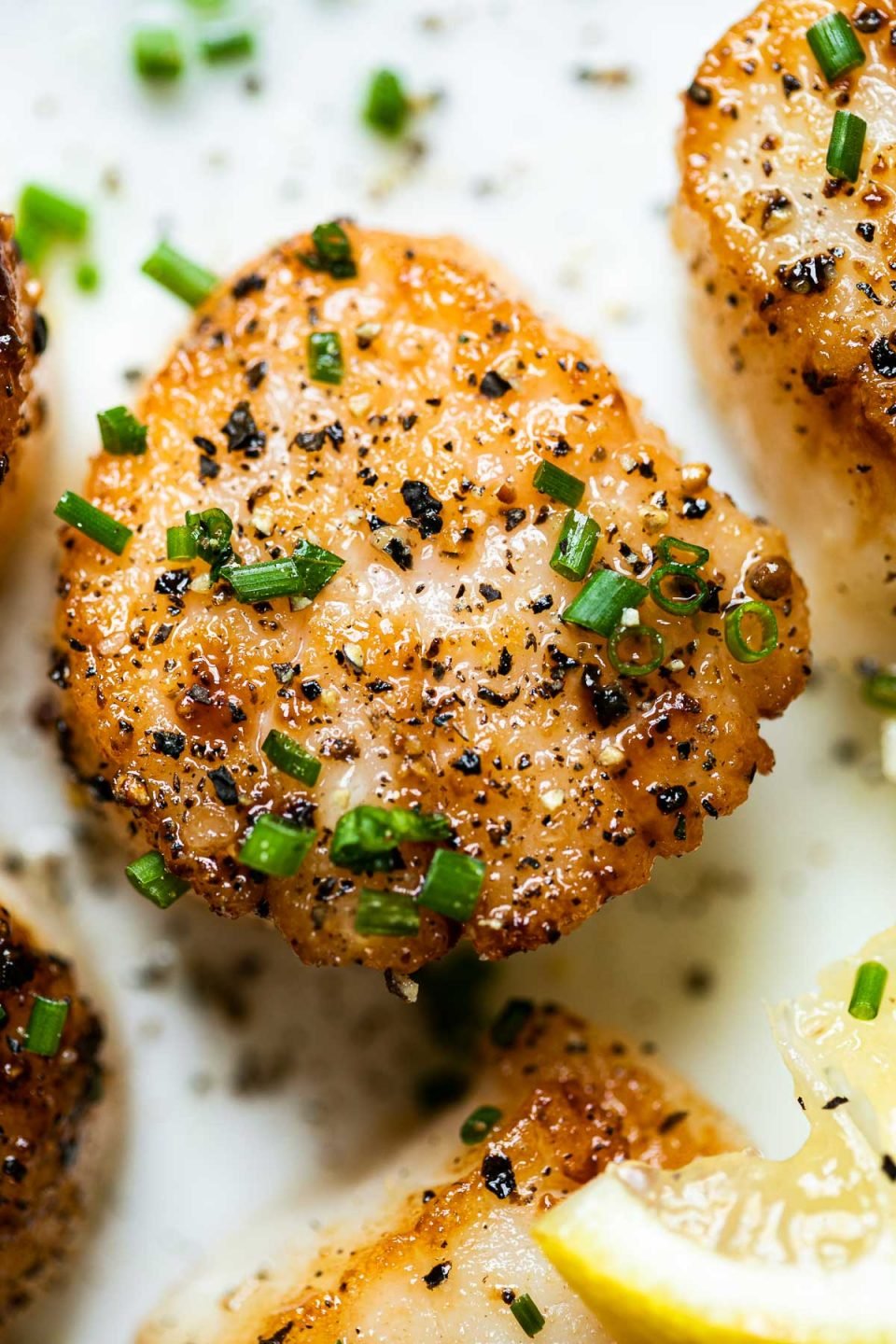
Key Ingredients & Equipment
The absolute best part about learning how to sear scallops at home is how simple it is. Unlike other fancy restaurant dishes, seared scallops are really easy to prepare, requiring very minimal ingredients & equipment. You will need…
- A skillet – Any nonstick or stainless steel skillet works beautifully for pan seared scallops.
- Scallops – This recipe is written specifically with jumbo sea scallops in mind, about U/15 – U/20. The “U” designation is a measure of size, indicating how many individual pieces make a pound. The smaller the U designation, the larger the scallops & vice versa (i.e. U/10 sea scallops are larger than U/30 sea scallops because only 10 individual scallops make up 1 pound vs 30). Sharing a few more scallops FAQs below!
- Oil – In my opinion, the best oil for cooking scallops is avocado oil. It’s neutral in flavor & has a high smoke point, which is ideal for seared scallops since developing a beautifully golden brown crust requires high heat. If you don’t keep avocado oil on hand, you can also make these pan seared scallops with another high smoke point oil (e.g. grapeseed, canola, etc.).
- Seasonings – I keep things simple with trusty kosher salt & ground black pepper. You can absolutely season your scallops with other spices (e.g. blackening seasoning, seafood spice blend, etc.) based on the other flavors of your meal.
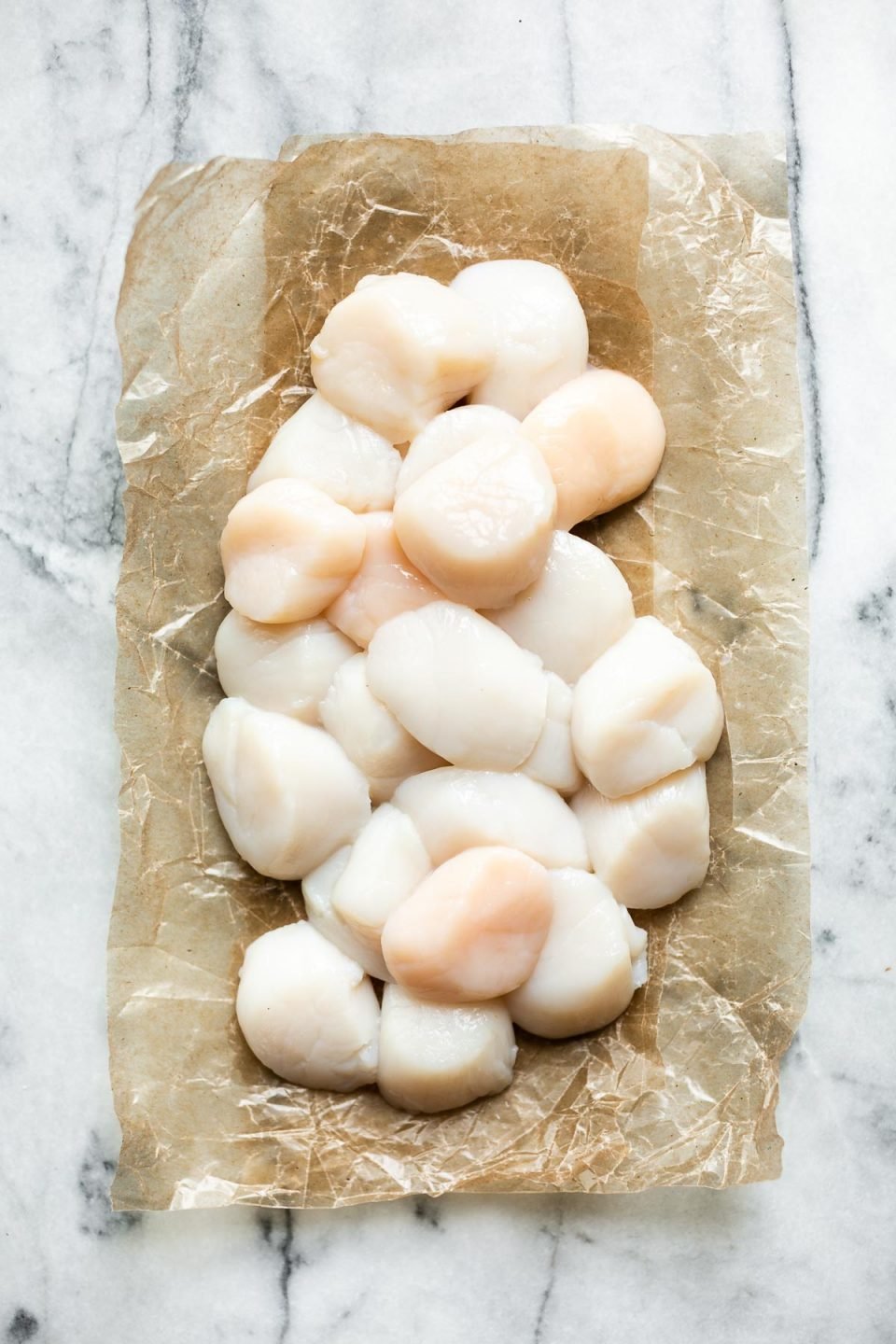
Scallops 101 – Choosing the right scallops:
- What’s the difference between bay scallops and sea scallops? ⇢ The two most common types of scallops are sea scallops & bay scallops. As their names suggest, sea scallops are caught in deep sea water whereas bay scallops are caught in shallow bay water.
- Sea scallops are larger in size (U/15-30), have a lovely firm texture, & pan sear beautifully. If you think of a restaurant dish with gorgeous seared scallops, sea scallops are likely what come to mind.
- Bay scallops are smaller in size (U/50-100), & they’re really delicate & sweet. Based on their small size, bay scallops cook very quickly, so they aren’t ideal for searing.
- What are diver scallops? ⇢ Another term you are likely to hear when you’re shopping for scallops is ‘diver scallops,’ which refers to the method in which the scallops are harvested. Diver scallops are harvested by hand (by divers!), a method regarded as more sustainable than commercially harvested scallops.
- Are frozen scallops good? Frozen vs fresh scallops ⇢ Conventional wisdom may dictate that fresh is best, especially when it comes to seafood. While there’s certainly some truth there, it’s a little more nuanced than that:
- Fresh ⇢ Unless you live on the coast, ‘fresh’ seafood is most likely previously frozen for transit to the store.
- Frozen ⇢ On the other hand, frozen seafood is typically frozen quickly after its caught, giving the final consumer more control to thaw immediately before use. In terms of freshness, I think frozen is the way to go! (& a bonus? Frozen is typically less expensive!)
- The best frozen scallops ⇢ Simple – ALDI’s Specially Selected Jumbo Scallops! They are wild-caught, certified sustainable, & individually frozen, which helps protect the integrity & flavor of delicate scallops. You’ll always find them in my freezer!
How to clean scallops & prep them for cooking:
Prepping scallops for searing is really simple! They need to be thawed (if frozen) & cleaned.
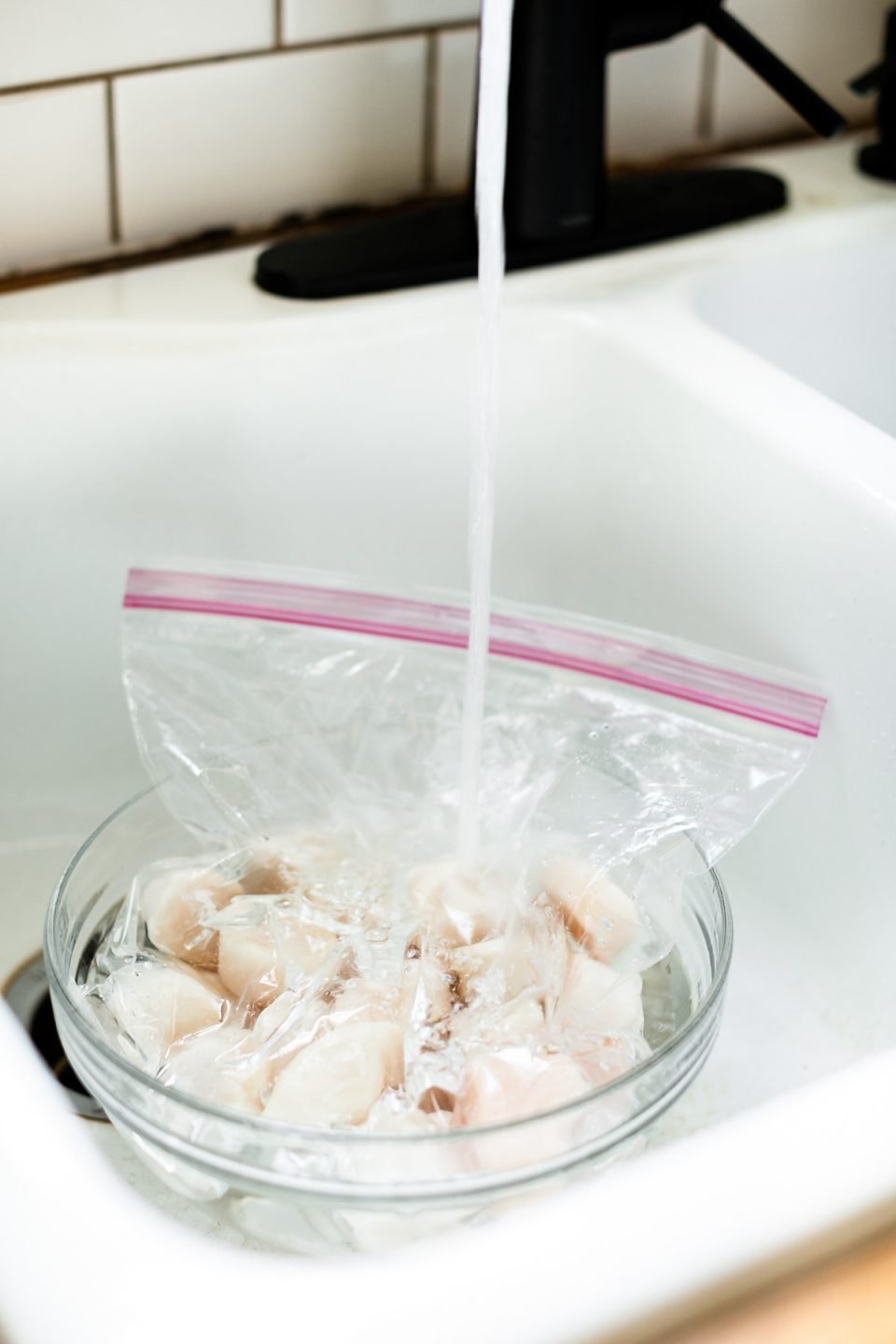
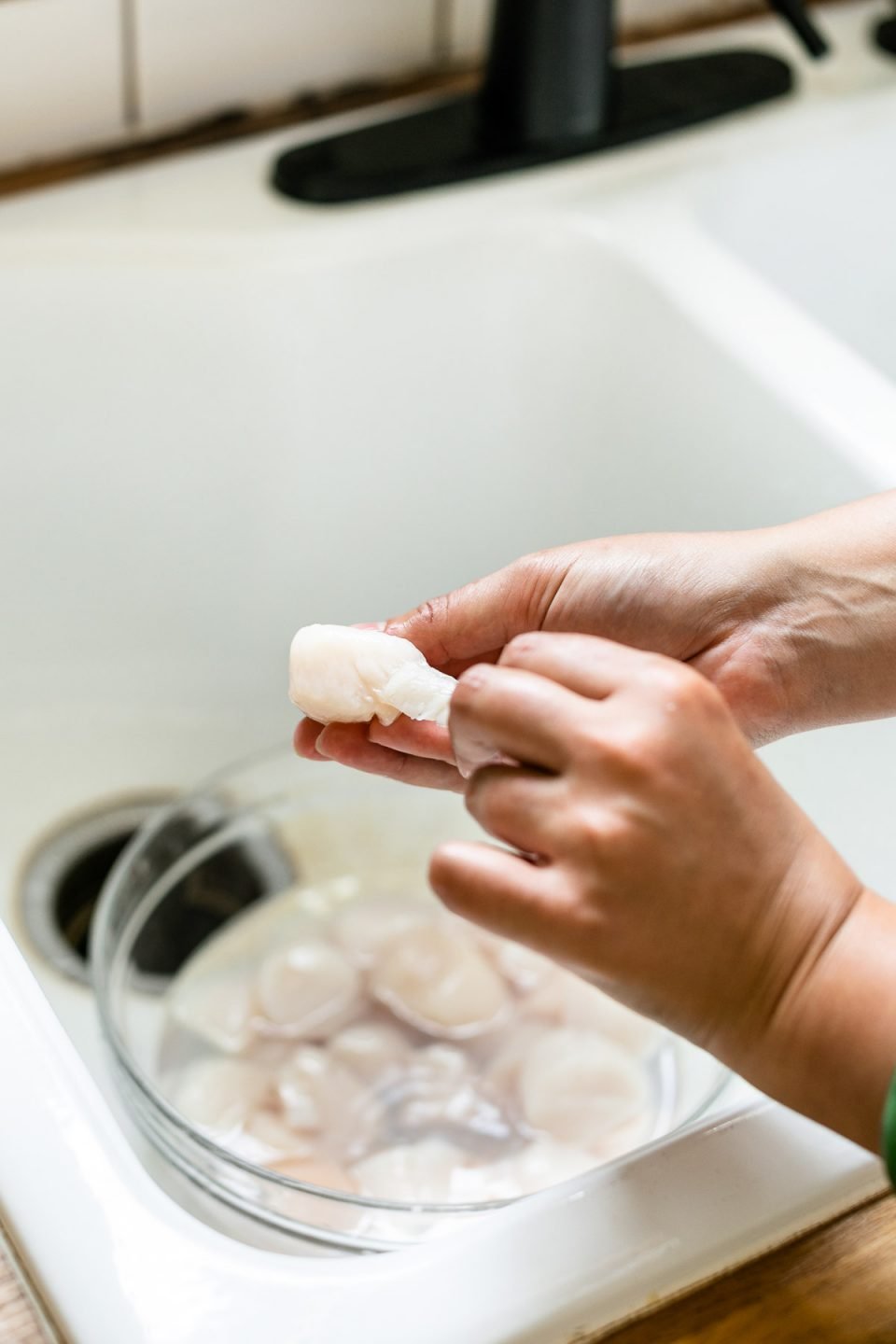
The best way to thaw frozen scallops ⇢ The best way to thaw frozen scallops, or any frozen protein for that matter, is to place them in a zip-top bag & submerge in cool water. Why ⇢ The steady, cool temperature of the water creates a really controlled environment for the frozen scallops to come up to room temperature. This is better from a food safety standpoint, since it limits bacterial growth. It’s also really quick – the scallops thaw in 25-30 minutes, tops!
How to clean scallops:
- Rinse! Remove the scallops from the packaging & quickly rinse under cold water. Why ⇢ If you’ve ever wondered ‘Why are my scallops gritty?‘, the grittiness you notice is likely sand. A quick rinse washes away any sand that may be hanging out on the surface of the scallop.
- Remove the side muscle ⇢ Check each scallop for its side muscle, which is really chewy & not particularly pleasant to eat. If present, it looks like a small, rectangular tag right along the side of the scallop, with its fibers running in the opposite direction of the fibers in the scallop itself. Use your fingers to gently tear it away.
- Pat dry ⇢ In order to take on a beautiful golden-brown crust, the scallops need to be as dry as possible. Transfer the cleaned scallops to a paper towel-lined plate. Gently press a second piece of paper towel over top to remove as much excess moisture as possible. If the scallops still seem pretty wet, pat with fresh paper towels until dry to the touch.
How to make pan seared scallops:
Making pan seared scallops at home may seem intimidating, but it honestly could not be simpler. It takes less less than 5 minutes to cook up a batch of perfectly juicy seared scallops with a restaurant-worthy golden brown crust. I promise you: once you master searing scallops, you’ll be totally hooked!
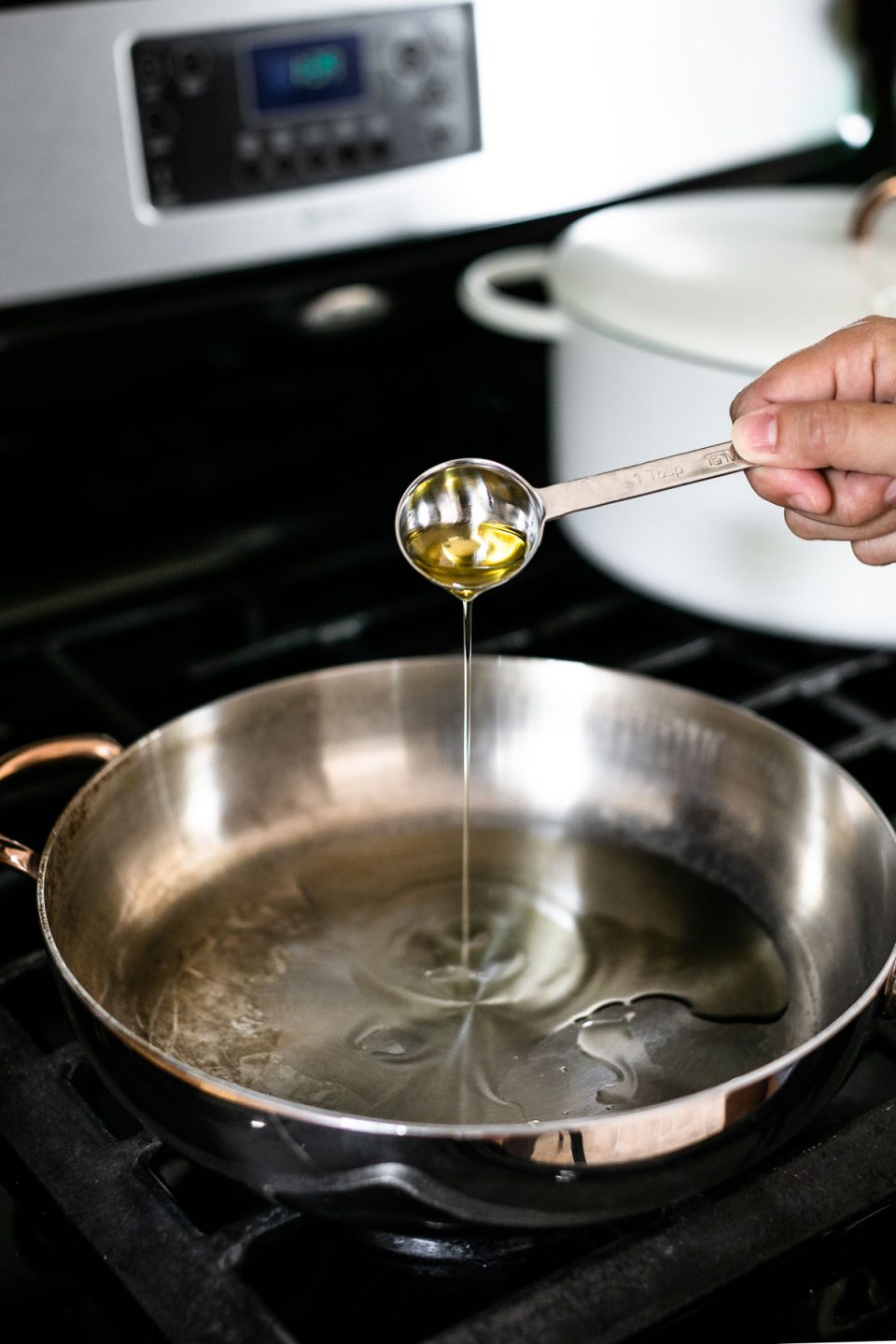
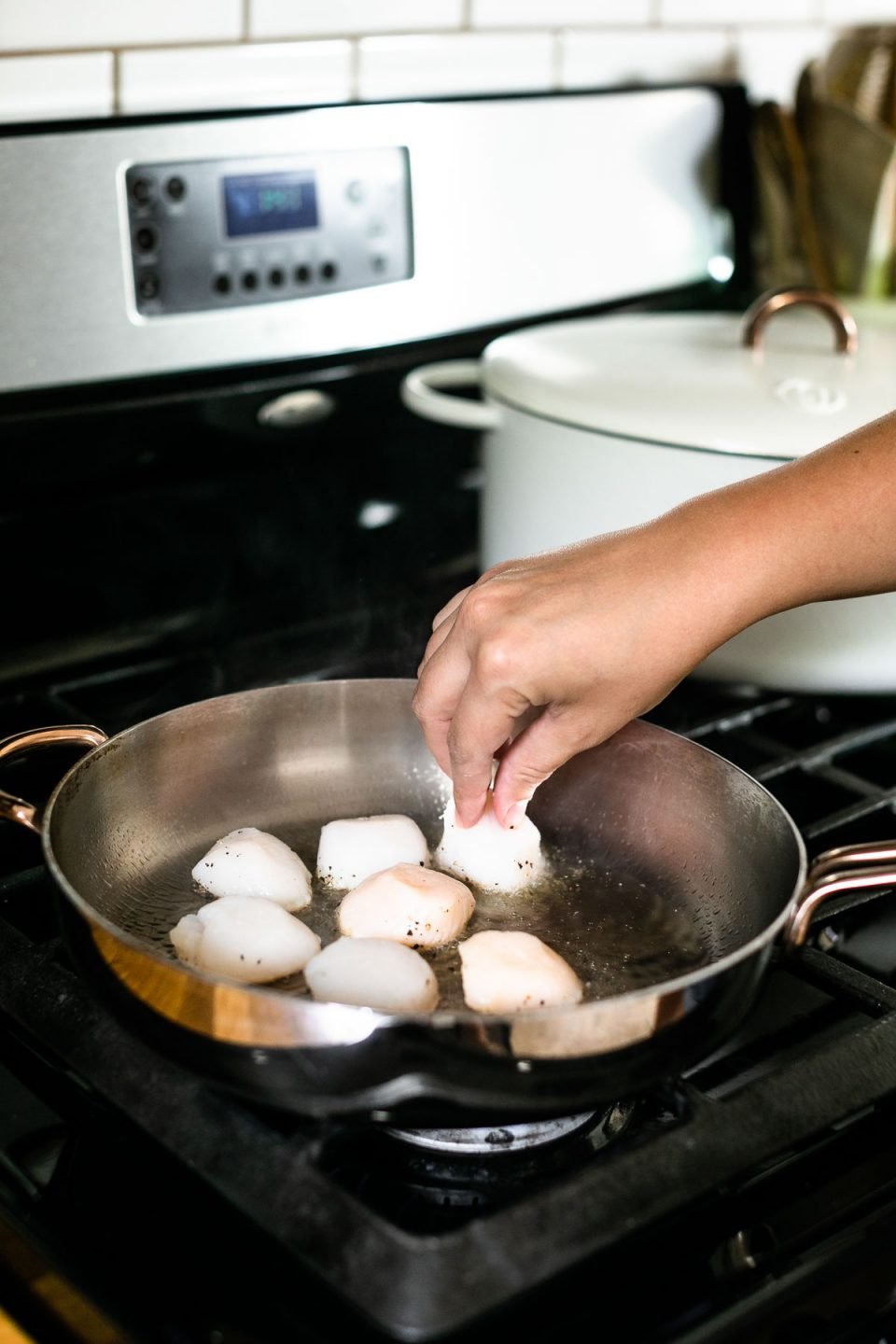
Here’s what you’ll do: (Note: full Recipe Directions are provided in the Recipe Card, below.)
- Heat the oil – Add the oil to a skillet over medium-high heat. I cook with stainless steel (pictured), but a good nonstick skillet will also work great for searing scallops. Why ⇢ A restaurant-worthy golden brown sear is a result of the scallops coming into direct contact with an an extremely hot surface (thanks to the Maillard reaction!). A good, hot pan is key for making the best pan seared scallops.
- Pat dry & season – Using paper towel, pat the scallops completely dry, then season generously with salt & pepper. Why ⇢ Moisture is the natural enemy to creating a good, hard sear, so it’s important that the scallops are as dry as possible.
- Sear the scallops – Once the oil is hot, add the scallops to the pan & cook for a couple minutes per side. The goal is gorgeous, hard sear, so refrain from disrupting the scallops much as they cook, though you can give the pan a gentle shake every 30 seconds or so to make sure the entire surface area of the scallop comes into contact with the hot pan. How long to sear scallops ⇢ Since they’re relatively small, scallops cook very quickly; about 2-3 minutes per side. You tell when scallops are done by looking at their sides; they will be opaque & no longer translucent.
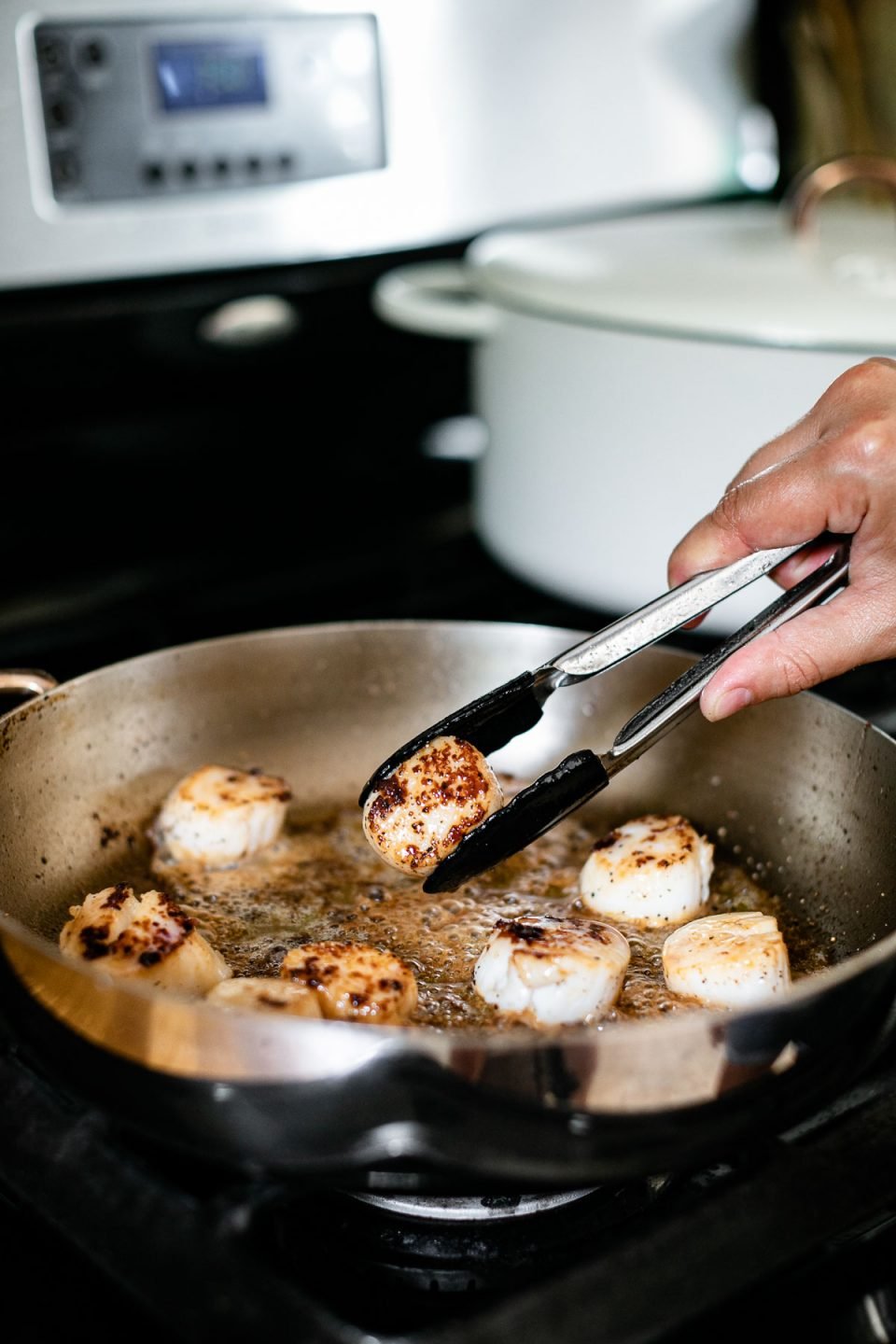
Troubleshooting – Are scallops supposed to be chewy?
A properly seared scallop has a gloriously golden brown & crusty exterior & is nearly melt-in-you-mouth tender & delicate throughout the center. If you find your scallops are rubbery or chewy, they’re likely overcooked. To fix, simply cook your next batch of scallops for a shorter amount of time. With a reduced cooking time, you may need to increase the heat under the pan to ensure they sear nicely & develop the coveted golden brown & crust. It may take a couple of batches to get the hang of how to sear scallops, but it’s so worth it!
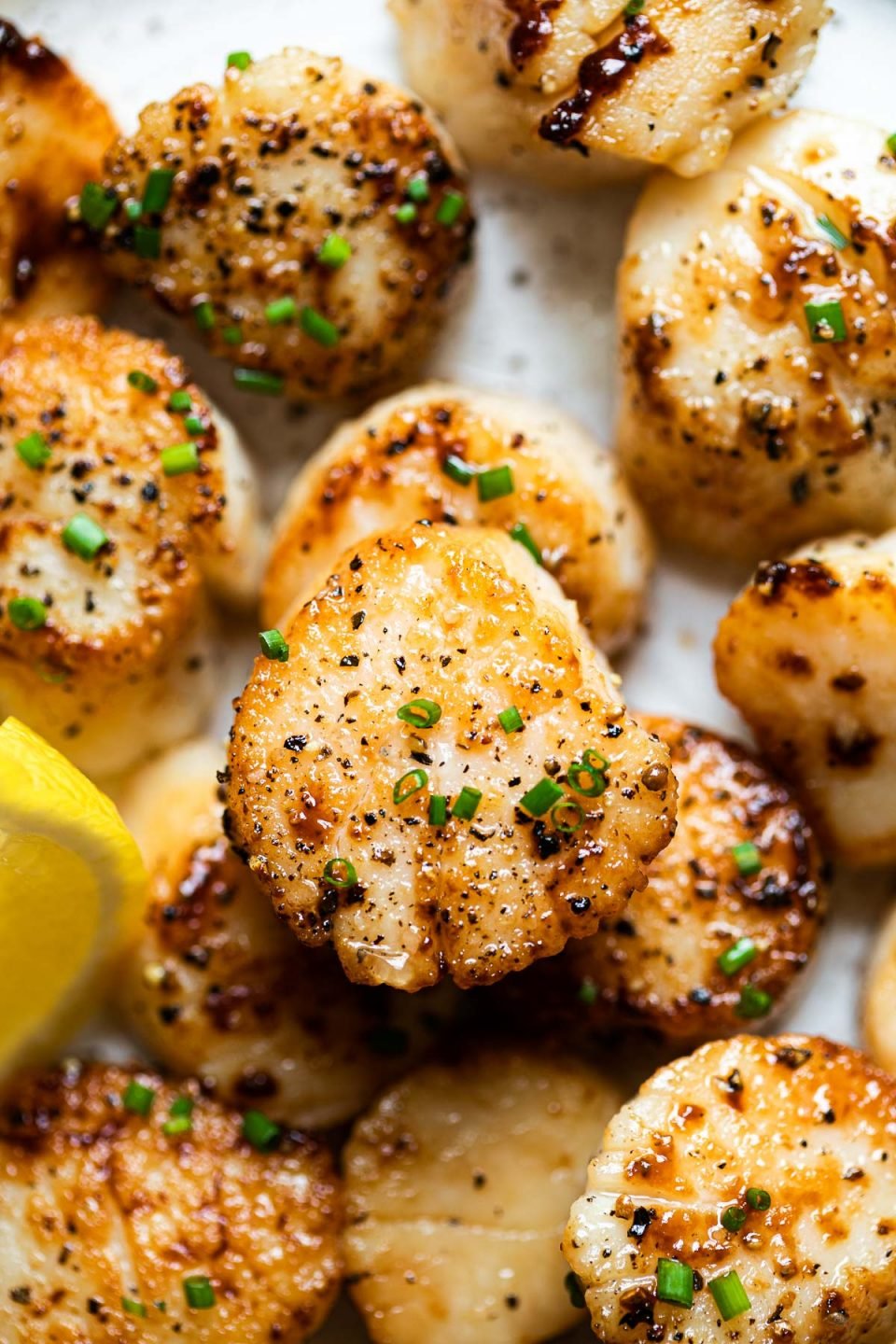
What to serve with pan seared scallops?
Pan seared scallops are gloriously versatile. You can serve them up in a countless number of ways. A few of my favorites…
- All on their own! – My personal favorite! Sprinkle the seared scallops with freshly snipped chives or thinly sliced basil, schmear some butter on your favorite crusty bread, pour a big ol’ glass of white wine, & dive in. If you want to fancy it up a bit, add sauce! An herbaceous drizzle of chimichurri or kale pesto is always a good idea.
- With pasta! – Seared scallops are the easiest way to take a simple pasta dish, like aglio olio, to the next level. This lemony Pesto Pasta with Seared Scallops is one of my all-time favorite meals.
- Surf & Turf – For an epic steakhouse-quality dinner, serve your seared scallops along with a beautiful steak & some mashed potatoes or a cozy gratin.
- Suggested wine pairing – I’m by no means a sommelier, but I enjoy pairing scallops with a crisp, dry white wine with good minerality, such as Sauvignon Blanc, Verdicchio, or an unoaked Chardonnay. Never shy away from telling the folks at your favorite wine shop that you’re looking for a pairing for scallops! They’ll always point you in a great direction.
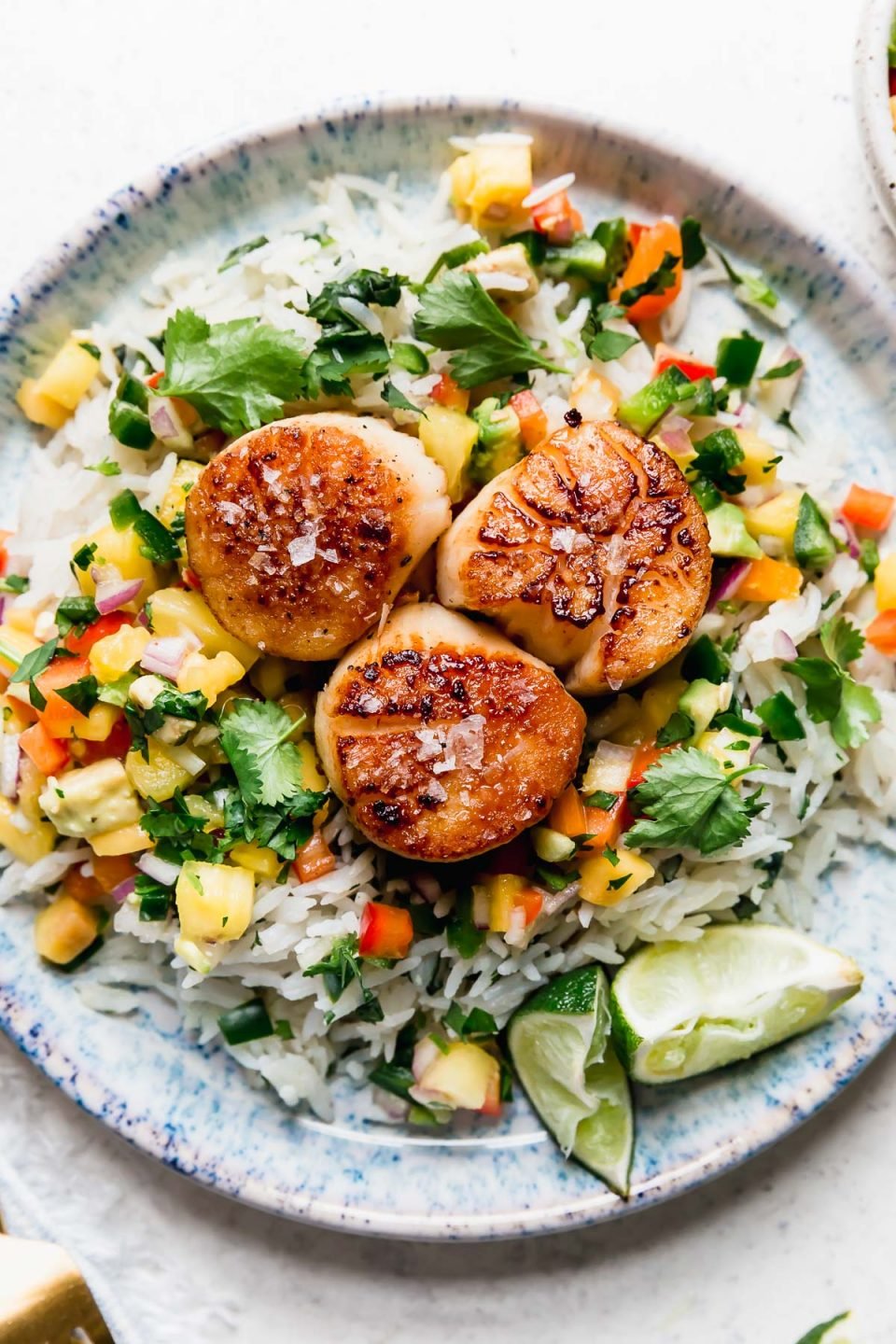
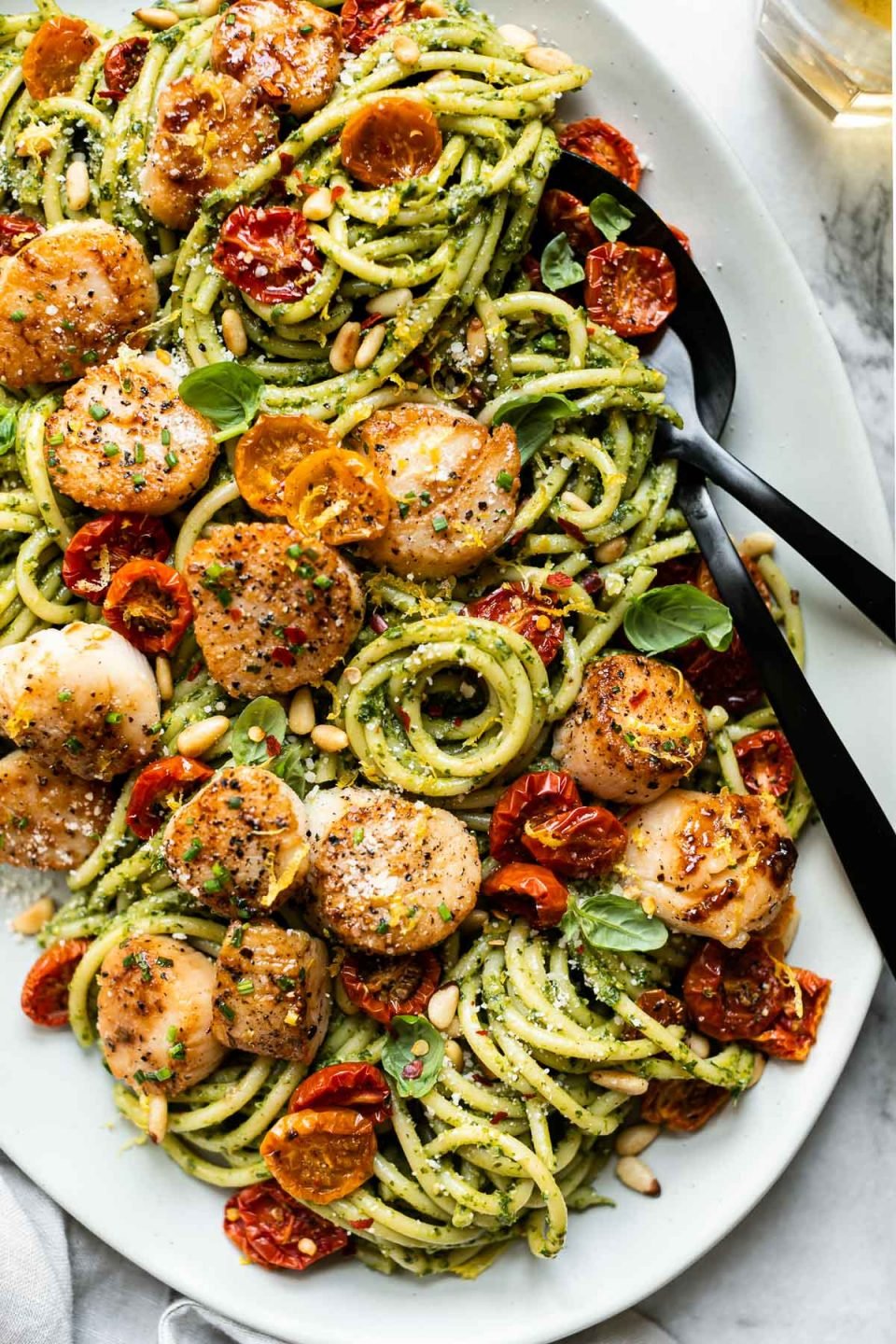
I cannot wait for you to have your hand at making these cuties! They’re truly best pan seared scallops at home. If you do give them a try, be sure to let me know!: Leave a comment with a star rating below. You can also snap a photo & tag @playswellwithbutter on Instagram. I LOVE hearing about & seeing your PWWB creations!
Want more easy but impressive dinner ideas? We are here to help! Check out my Creamy Pork Marsala with Mushrooms or this Springtime Mascarpone Pasta next. Happy cooking! ♡
Print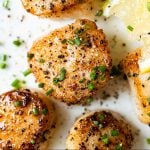
Pan Seared Scallops (How to Sear Scallops at Home)
- Prep Time: 5 minutes
- Cook Time: 5 minutes
- Total Time: 10 minutes
- Yield: serves 3-4 1x
- Category: main dishes, seafood
- Method: stovetop
- Cuisine: American
- Diet: Gluten Free
Description
How to Sear Scallops absolutely perfectly every single time…it’s easier than you think! Beautifully golden brown & juicy pan seared scallops are simple to make at home. Serve them on their own alongside lemons & crusty bread, toss them into a healthy pasta dinner, pair with roasted winter veggies, & more.
Ingredients
- 1 pound jumbo sea scallops, U/20-30 (see Recipe Notes)
- 2 tablespoons avocado oil (or another high smoke point cooking oil, such as grapeseed, corn, peanut, canola, etc.)
- kosher salt & ground black pepper
Instructions
- Scallops prep: Working one by one, give the scallops a quick rinse under cold water to rinse away any sand that might be stuck on the flesh of the scallop (this helps prevent gritty seared scallops). Check each scallop for its adductor muscle – if present, it looks like a small, rectangular tag positioned right along the side of the scallop, with its fibers running opposite the fibers in the scallop itself. Use your fingers to gently tear it away. Some of your scallops may not have their side muscle attached – totally normal! Transfer the cleaned scallops to a paper towel-lined plate. Gently press a second piece of paper towel over top to remove as much excess moisture as possible. Set aside.
- Searing prep: Add the avocado oil to a large nonstick or stainless steel skillet over medium-high heat. Season the scallops generously with kosher salt, about 1 teaspoon per pound. If desired, season with cracked black pepper. If the salt draw some moisture to the surface of the scallops, use a fresh paper towel to pat dry again.
- Sear the scallops: Once the oil is hot, carefully transfer the scallops to the skillet. Work in batches, as needed, to avoid overcrowding the pan. Cook, giving the pan a gentle shake every so often, for 2-3 minutes, until a deep golden crust has formed on bottom of the scallops. Flip and cook for 1-2 minutes more. You will be able to tell that the scallops are cooked through when the side of the scallop is opaque top-to-bottom. Transfer the seared scallops to a fresh paper towel-lined plate. Repeat with any remaining scallops, adding extra oil to the pan as needed.
- Serve immediately: You can enjoy your perfectly pan-seared scallops with crusty bread & a big squeeze of fresh lemon juice, drizzle them with herbaceous sauces like chimichurri or pesto, or pair with your favorite dishes. Pan-seared scallops are a great, easy seafood option to pair with steak for a surf & turf dinner at home. They’re also great on pasta – my favorite is this Pesto Pasta with Seared Scallops. Enjoy!
Equipment
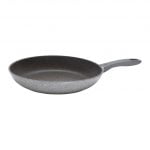
Ballarini Parma Plus 12-Inch Non-stick Frying Pan
Buy Now →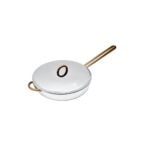 Buy Now →
Buy Now → 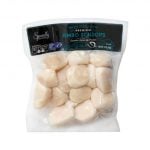
ALDI Specially Selected Jumbo Scallops
Buy Now →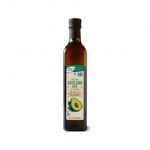
ALDI Simply Nature 100% Avocado Oil
Buy Now →Notes
- “U” designation: This recipe is written specifically with jumbo sea scallops in mind, about U/15 – U/20. The “U” designation is a measure of size, indicating how many individual pieces make a pound. The smaller the U designation, the larger the scallops & vice versa (i.e. U/10 sea scallops are larger than U/30 sea scallops because only 10 individual scallops make up 1 pound vs 30).
- Frozen vs fresh scallops: Conventional wisdom may dictate that fresh is best, especially when it comes to seafood. While there’s certainly some truth there, it’s a little more nuanced than that. Unless you live on the coast, ‘fresh’ seafood is most likely previously frozen for transit to the store. On the other hand, frozen seafood is typically frozen quickly after its caught, giving the final consumer more control to thaw immediately before use. In terms of freshness, I think frozen is the way to go! (& a bonus? Frozen is typically less expensive!)
- Thawing frozen scallops: The best way to thaw frozen scallops, or any frozen protein for that matter, is to place them in a zip-top bag & submerge in cool water. The steady, cool temperature of the water creates a really controlled environment for the frozen scallops to come up to room temperature. This is better from a food safety standpoint, since it limits bacterial growth. It’s also really quick – the scallops thaw in 25-30 minutes, tops!
Recipe and Food Styling by Jess Larson, Plays Well With Butter | Photography by Rachel Cook, Half Acre House.
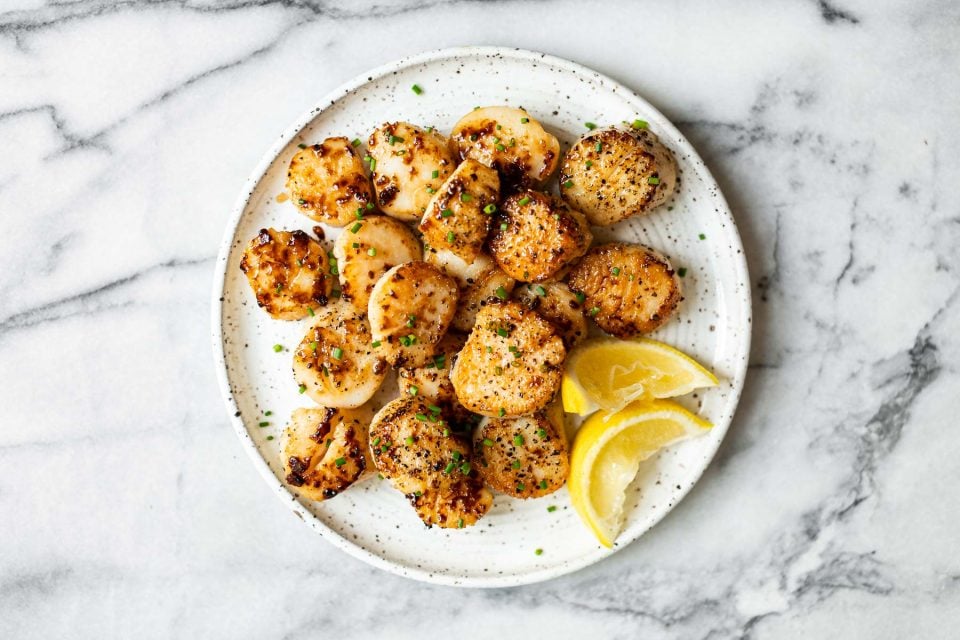
Follow along with Plays Well With Butter on Instagram, YouTube, Facebook, and Pinterest for more unfussy recipes that pack a big punch of flavor!


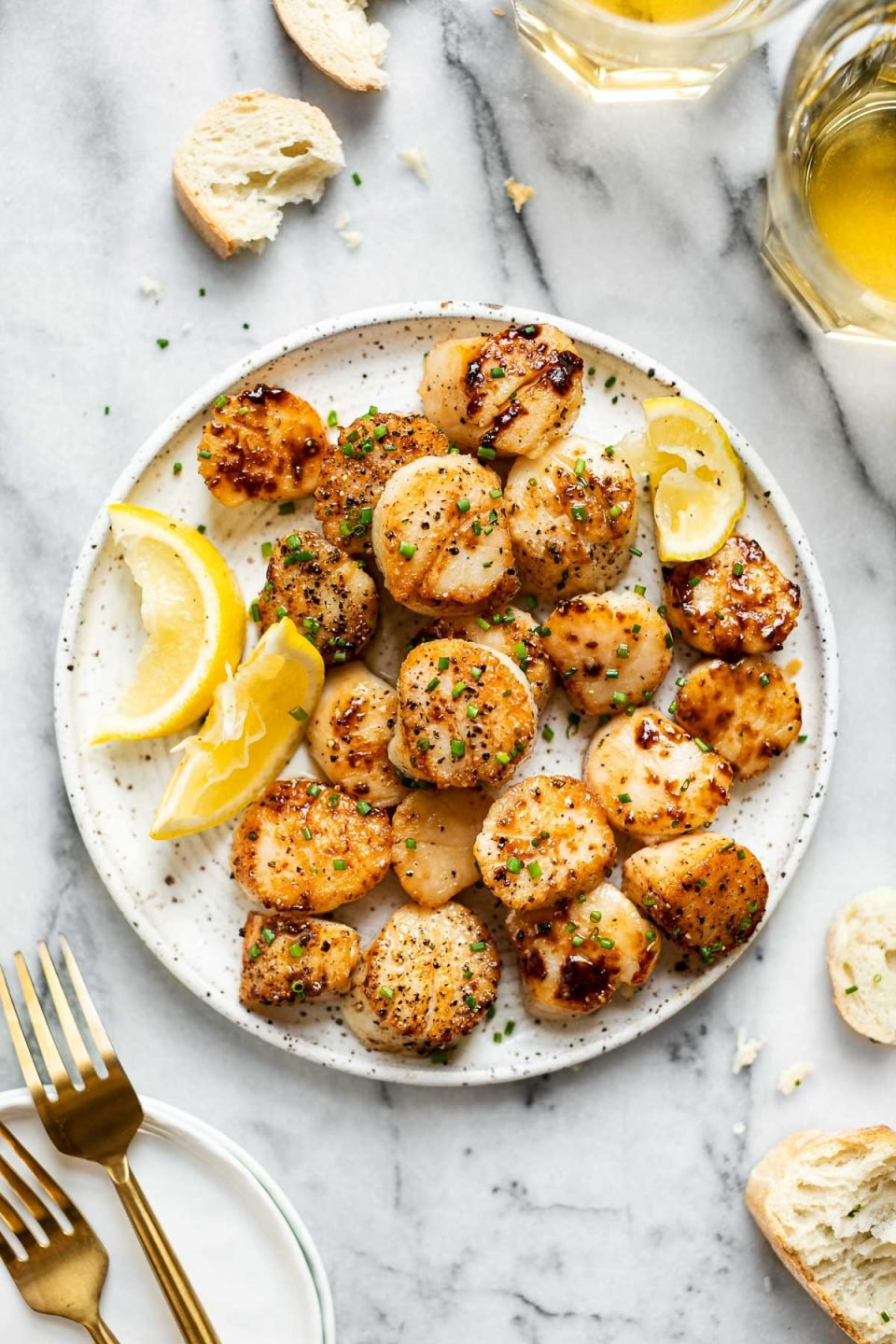
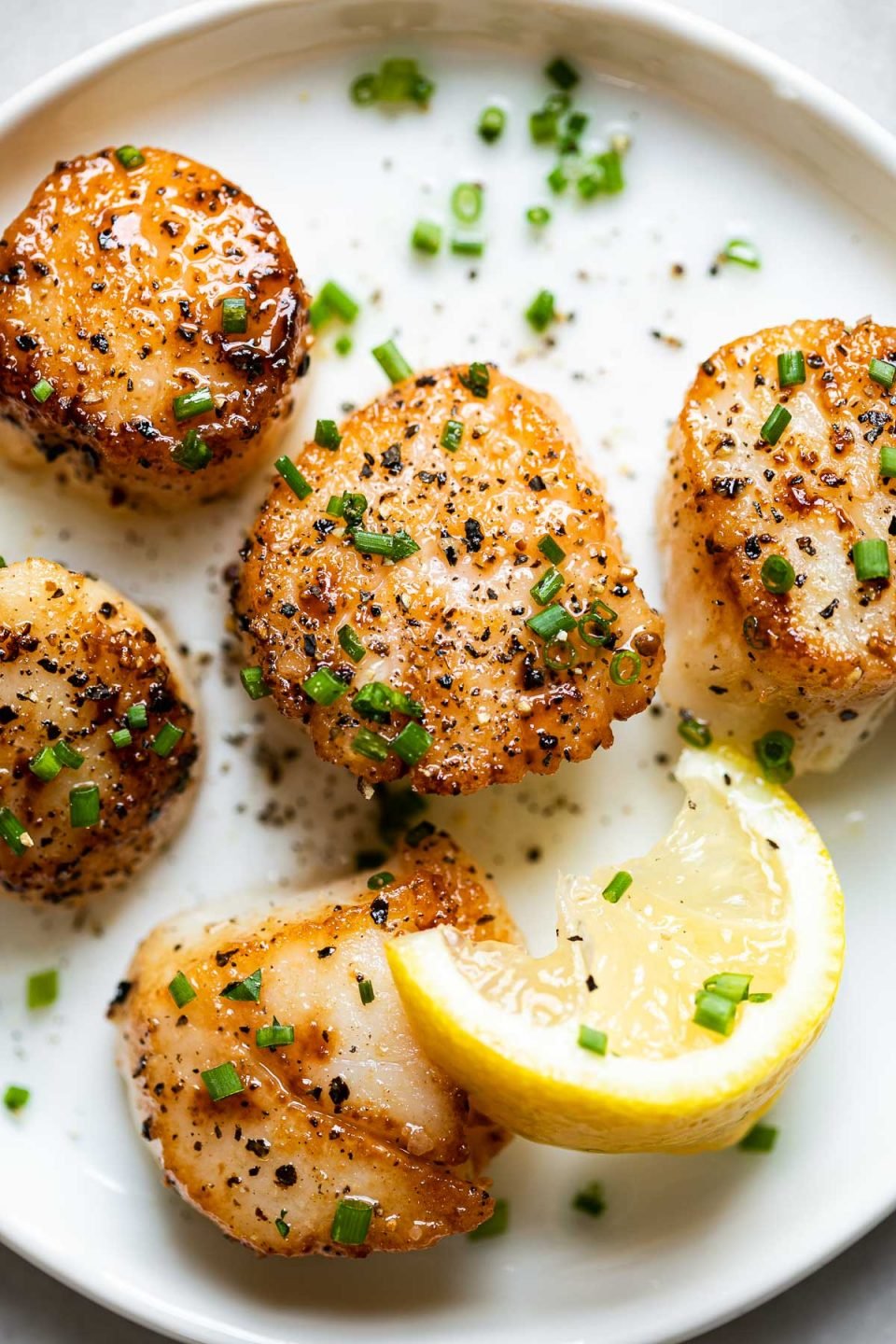
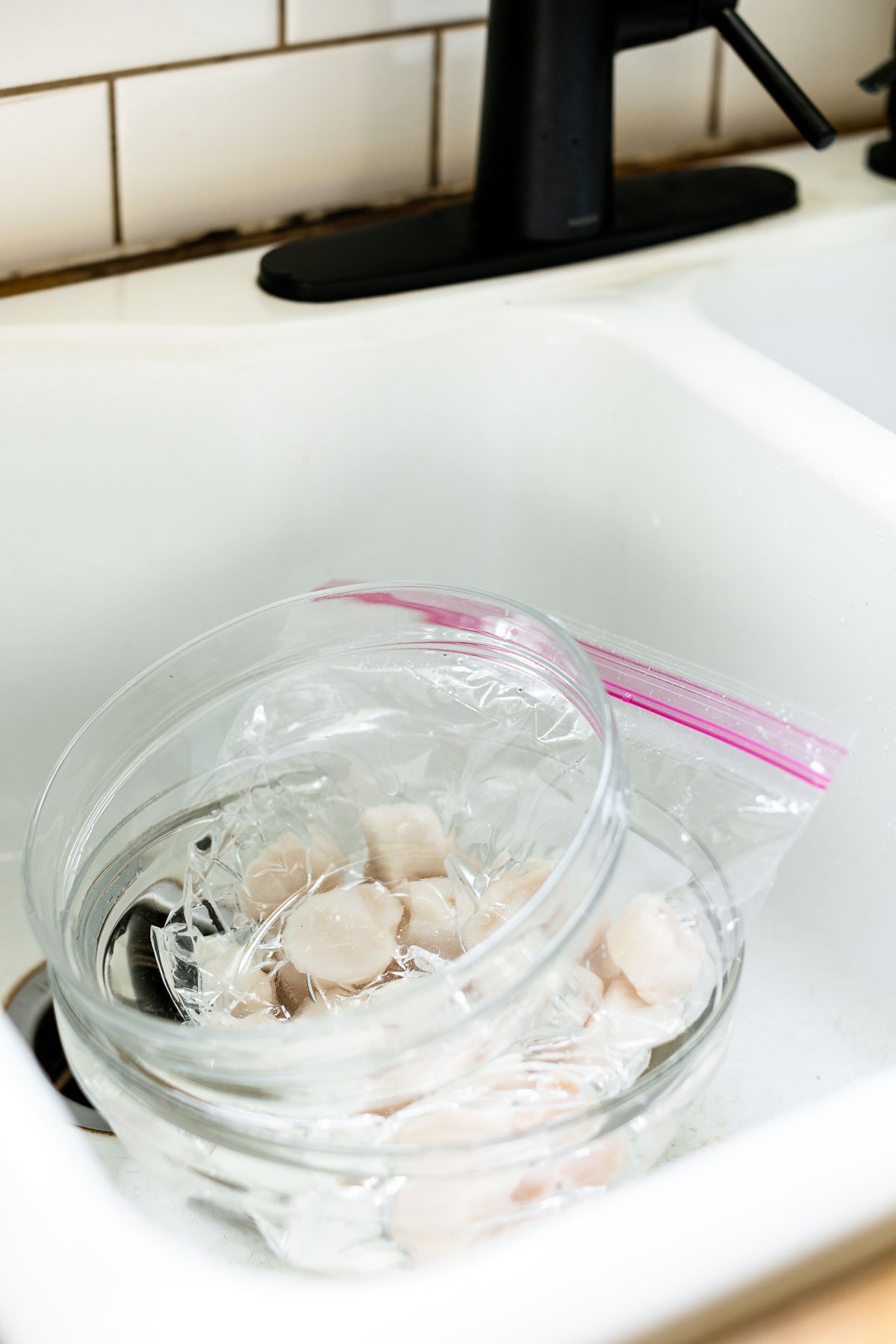
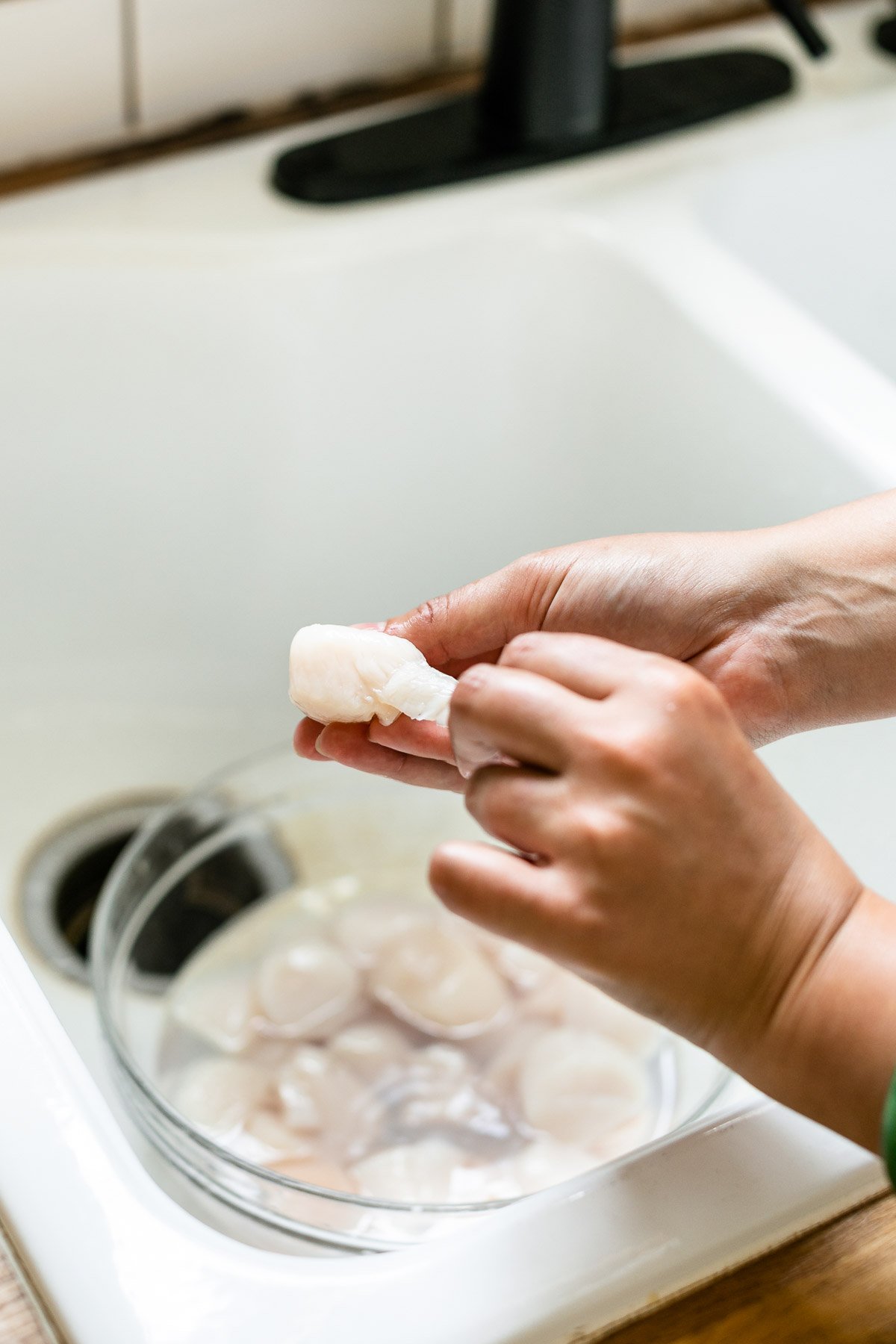
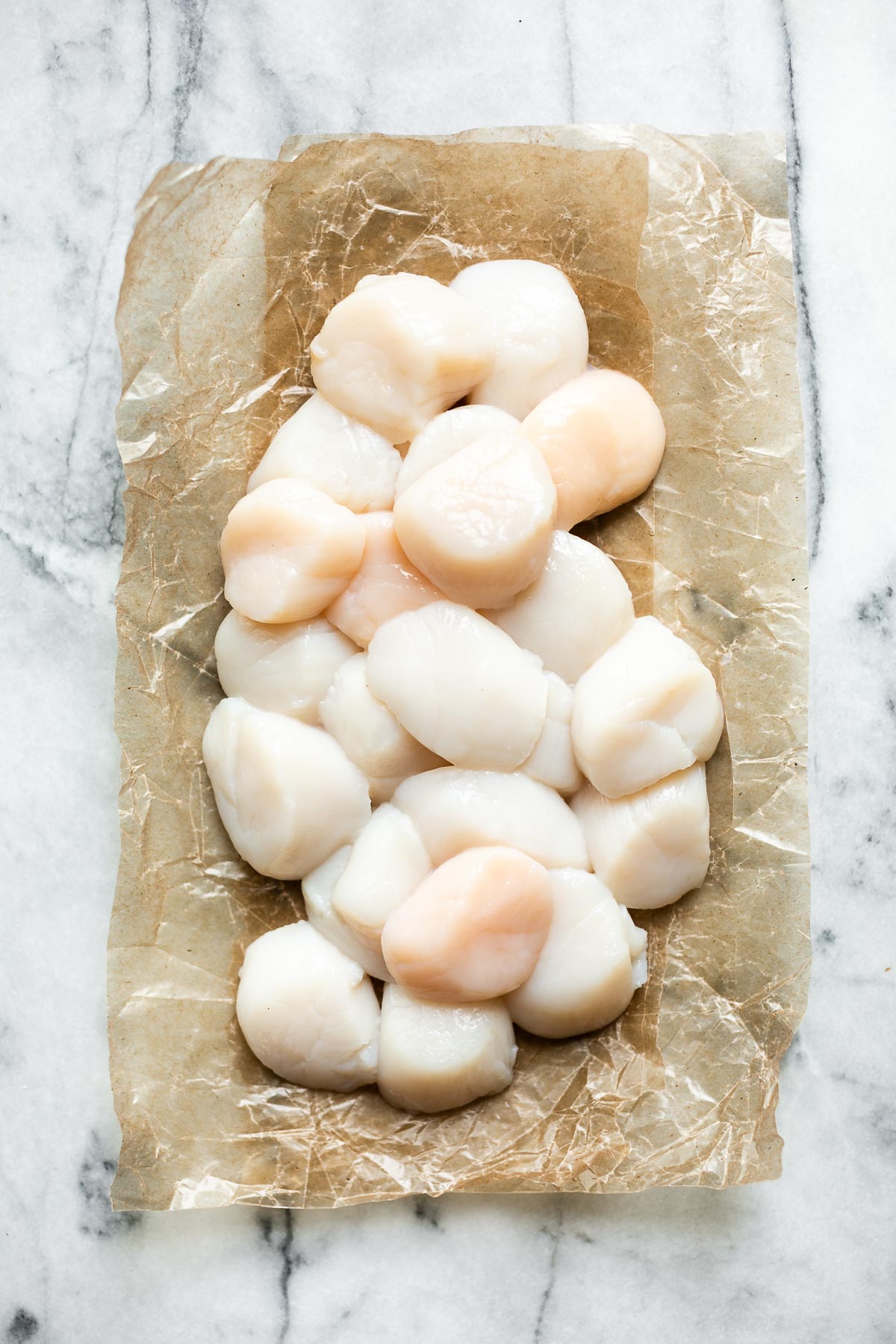
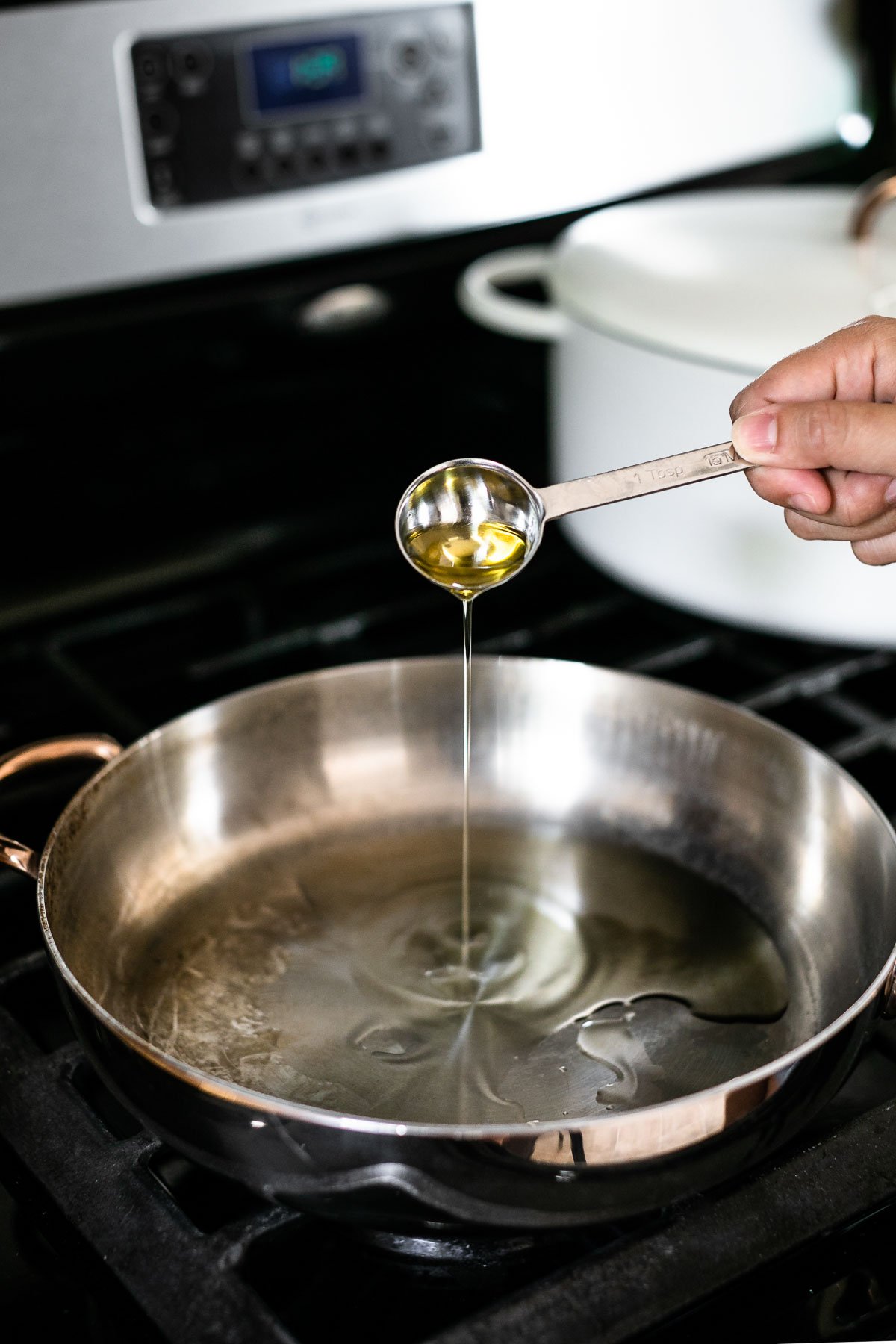
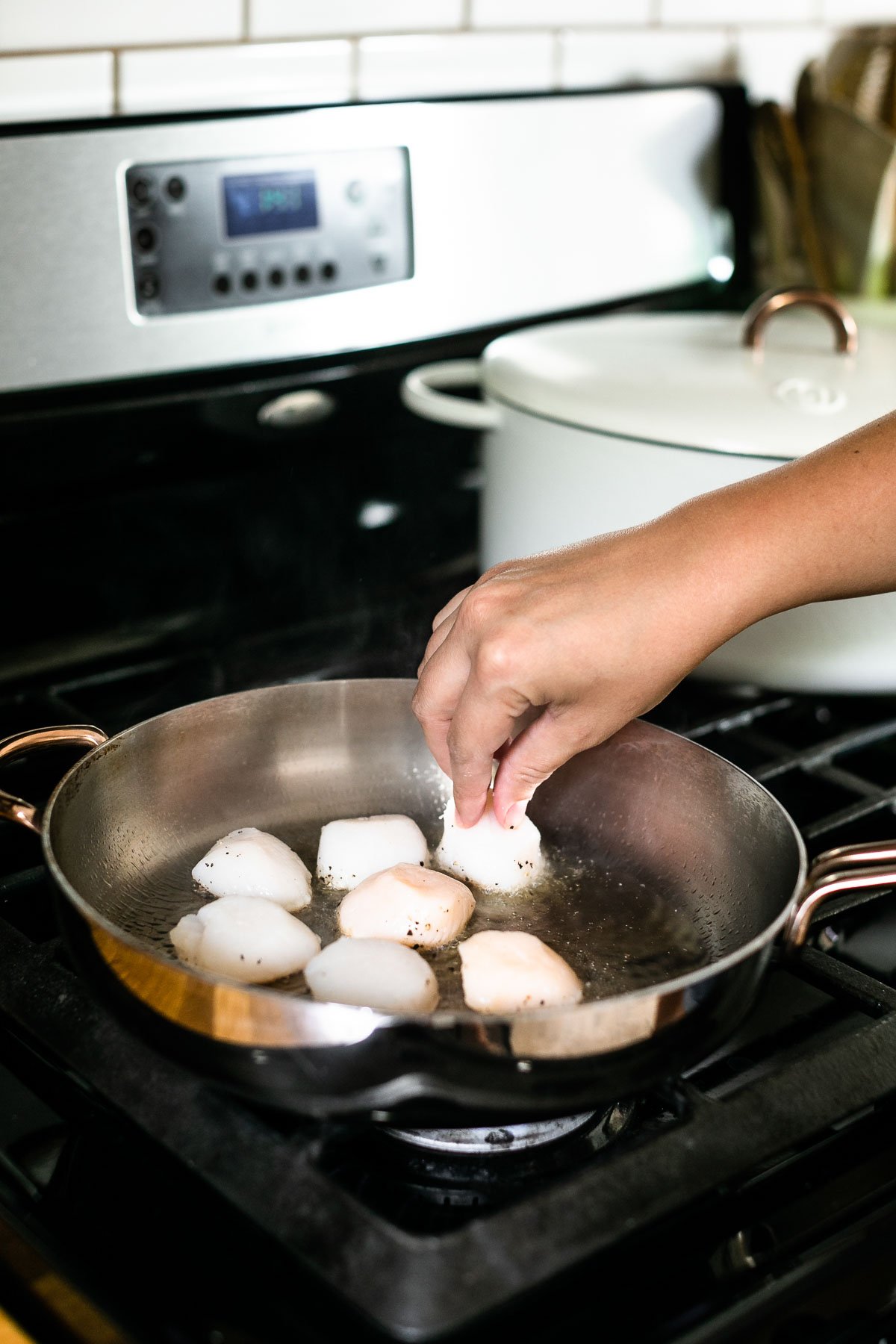
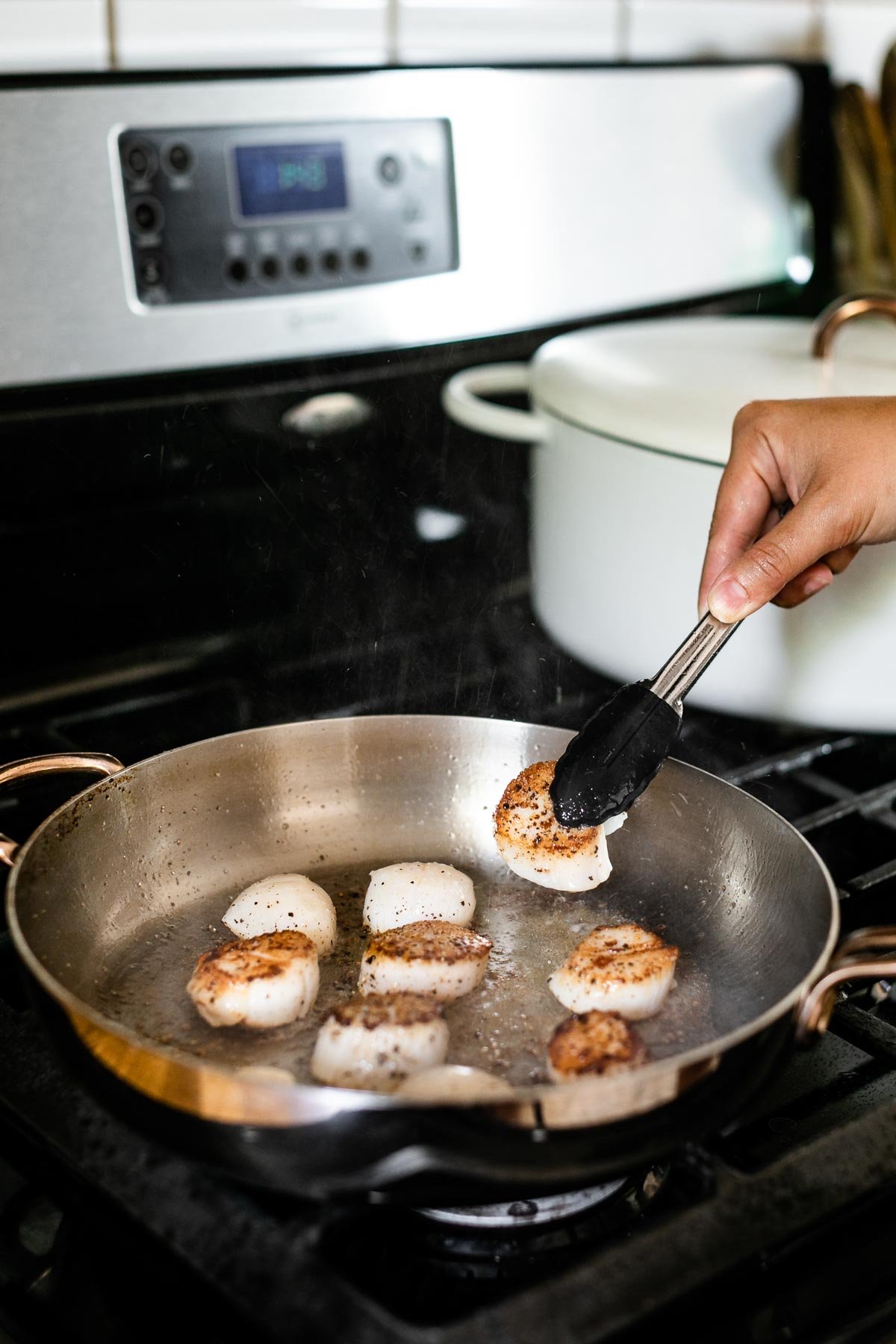
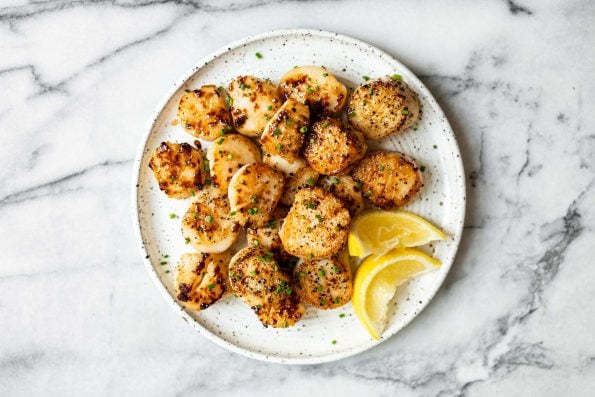
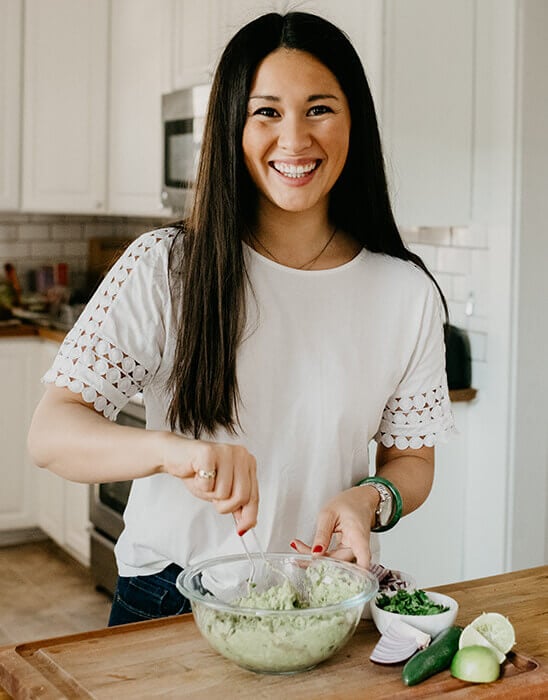
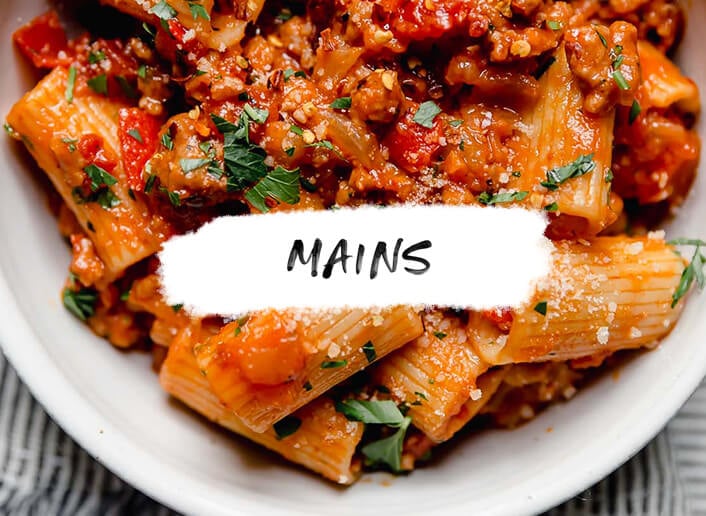
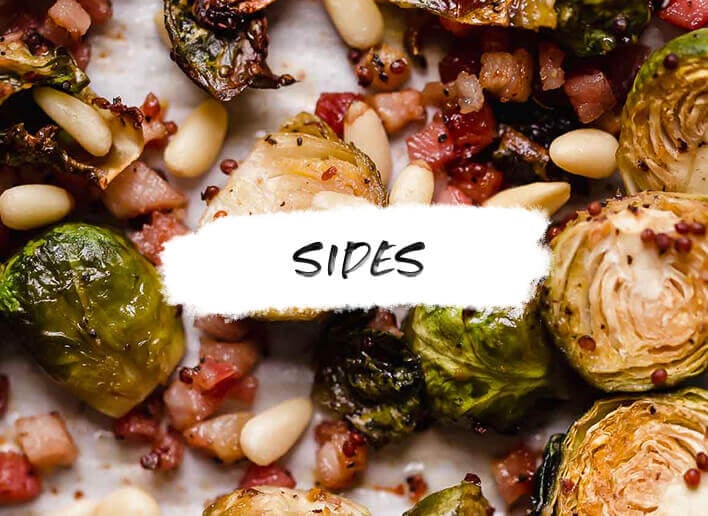


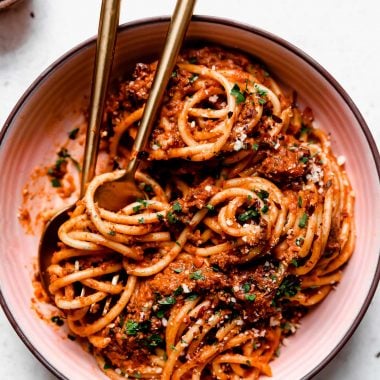
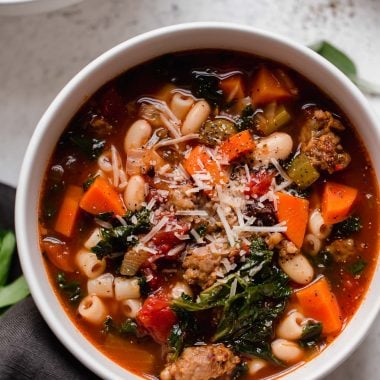
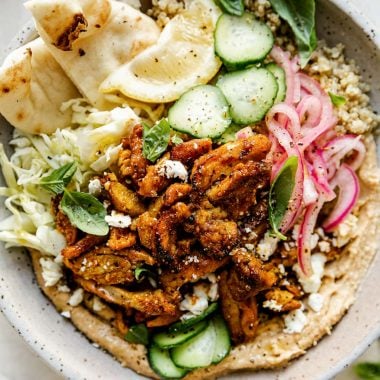
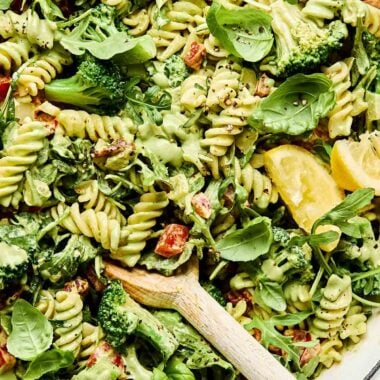
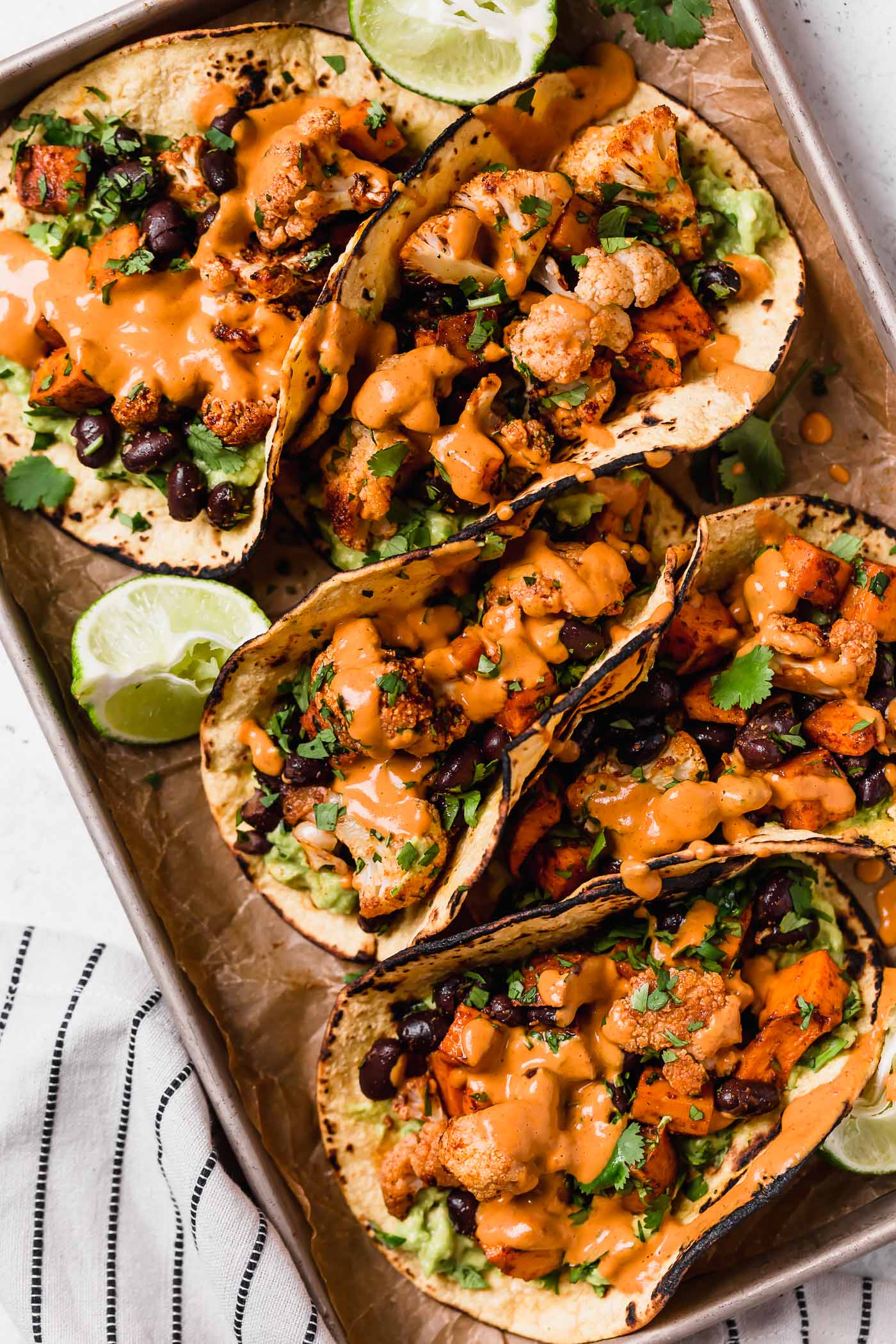
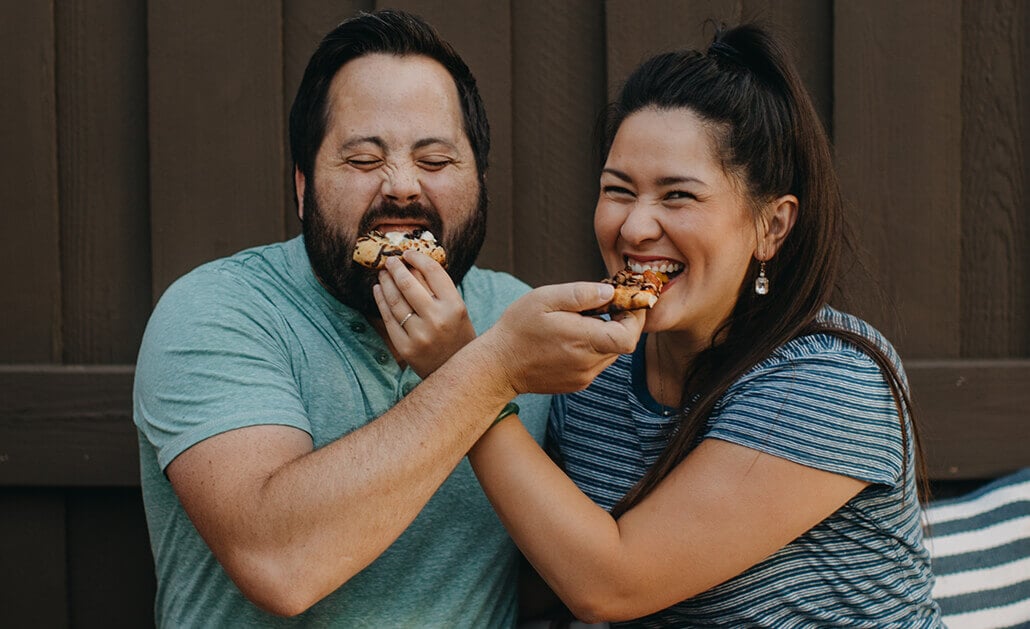
I’ve made the mistake in the past of pressing all liquid out of a previously frozen tuna fillet in order to get it dry for cooking. I ended up with the driest, grossest tuna ever. So when you say “pat dry”, is the goal just to get the exterior dry, while leaving as much moisture inside?
Hi Anna, yes, you’ll just pat the exterior dry 🙂 Hope that helps!
This is my go-to recipe for preparing scallops. I used to be scared to make them, but the instructions make it a breeze. We like to pair them with risotto and spinach.
So awesome to hear Cameron & that pairing sounds delicious! If you like pasta too you should try our Scallop Pesto Pasta next!
So. Easy. I am always intimidated by cooking seafood, and this recipe has dangerously erased my fears. We paired with steak for surf and turf on the back deck. *chefs kiss*
Seriously easy and delicious! I’m always afraid of over or undercooking scallops and these came out perfect.
Such a thorough and helpful guide! Thanks Jess! I can’t wait to try these!
Thanks for the comment, Jamie! Can’t wait to see your beautiful scallops! xx